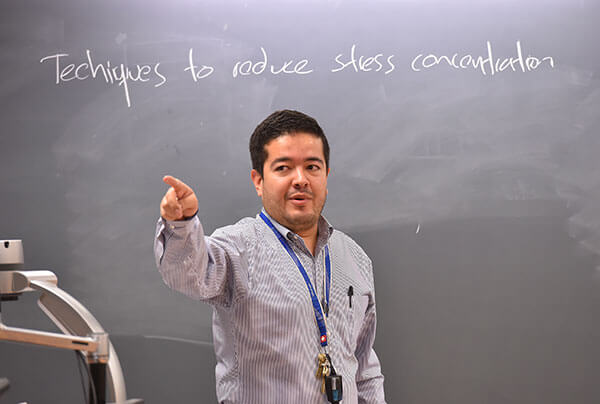July 14, 2020
In response to the coronavirus pandemic, the St. Mary’s University community has adapted — faculty stepping up to deliver quality education to students from a distance.

Juan Ocampo, Ph.D., Associate Professor of Mechanical Engineering, shared takeaways from his spring classes in a Q&A. Ocampo joined St. Mary’s in Fall 2016. He specializes in probabilistic fatigue analysis, damage tolerance of aircraft structures and teaches in the area of mechanical design. In Spring 2020, he taught Strength of Materials, Foundations of Practice: Ethics, and Senior Design Project.
Q: What was your approach in switching to online learning in a short period of time?
A: My approach was to always think about my students first. To make sure they were doing okay by checking on them and their individual situations to be able to adapt to the current situation. And then I looked for what technology could help us to keep the St. Mary’s experience in an online environment.
Q: What are some new teaching methods you’ve picked up along the way?
A: Some of the teaching methods I used were flipping the classroom and asking students to be prepared before they showed up to class so we can use the class time for discussions. And then doing active learning during the class period. I also used Zoom’s (a cloud-based videoconferencing platform) breakout rooms to do project-based learning, which is to give a prompt or an activity to students so they can solve it as a group. They then come back to the main section in Zoom to share their ideas with the whole class.
Right now, I’m still searching and reading a lot online for new techniques I can implement in the fall.
Q: What has been your biggest area or opportunity for growth in teaching online thus far?
A: My biggest area for growth has been to create assessment activities to better engage my students in an online environment. Some of those activities include coming up with no trivial, or single-solution, design problems, which students will discuss as a group and find the best solution for an engineering problem. For example, I asked my students to design a machine to build tall structures without using a crane using the principles of strength of materials. I was very happy with how creative they were in developing their designs.
Another opportunity for growth is for me to get closer to my students by conducting individual sessions with them to ensure they’re able to learn all the concepts when they are away from the classroom.
Q: What has been most surprising?
A: I found two things very surprising. The first is how easily our students can adapt and respond to big challenges. The second is finding that many of my students who are shy in the classroom were more engaged in an online environment. Many of them felt more comfortable asking questions through Zoom’s chat function.
Q: What has been the most beneficial experience of teaching online?
A: The most beneficial experience for me was redesigning my classes and having to think outside the box, being able to develop new activities for students to make their learning more engaging.
Also, learning new technology tools and skills that will benefit my students’ learning.
Q: Students look to you for guidance, for wisdom, especially during times of crisis. How have you managed your own challenges and anxieties during this time?
A: Always keeping a positive attitude and trying to maintain a community sense — connecting with my students, with my family and also other faculty members. I’m very grateful to be part of the St. Mary’s family, which has supported me in all my daily activities.
